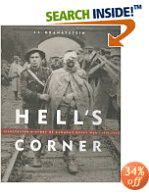Hell's Corner: An Illustrated History of Canada's Great War, 1914-1918

by J. L. Granatstein
ISBN: 1553650476
Post Your Opinion | | A Review of: HellÆs Corner: An Illustrated History of CanadaÆs Great War 1914-1918
by James RootsJ. L. Granatstein hardly needs introduction, but if he did, he
certainly accomplished it by publishing no fewer than four books
in the past year (with two more coming out this spring). One senses
that he can whip off two or three war books on any rainy afternoon
not only because our war history is by now completely ingrained in
his synapses, but also because he has the gift of writing brisk
sentences. Even when he is wasting words, he is doing so at a
refreshing sprint.
With Hell's Corner: An Illustrated History of Canada's Great War
1914-1918, it takes him only about 150 pages of text to provide a
complete, detailed account of Canada's experience in World War One.
There is no count provided of the illustrations, but it looks like
around 100 photos, posters, paintings, drawings, cartoons, and
colour maps.
Granatstein brings a voice of total authority to his work. He is a
master, nothing less, of integrating first-person quotes to add
both colour and credibility to his narrative. His account of the
first gas attack at Ypres is powerful enough to make the reader
wheeze for breath; and after providing 12 or 13 pages of the best
description of Passchendaele ever written, he nails the horror and
disgust with the sharp line: "Men had to struggle merely to
survive; that they had to fight was almost inhuman." He uses
perfect selection of facts to pound home points such as the staggering
casualty rate for pilots:
" in April 1917, No. 60 Squadron of the RFC, based near Arras,
France, suffered a 110 per cent casualty rate with thirteen of
eighteen of the original pilots shot down, along with seven
replacements."
Rather surprising for such an opinionated writer, Granatstein
displays a fine balance of judgment. Proud of our troops'
accomplishments, he nonetheless points out they were not only the
best but also the dirtiest fighters, notorious for looting prisoners
and corpses of even the most personal items such as family photos
and love letters, possessors of the highest incidence of STD among
all the armies, worst drunkards among the Allied Powers, the most
frequent users of poison gas (a very little-known fact), and the
deliberate killers of surrendering enemies.
If there is any disappointment with the text, it is the spare use
of Granatstein's delightful wit. The only time he lets it off the
leash is when he suggests Canadian troops didn't complain much about
trench food because "such a high proportion of the Canadian
Corps was British-born and used to unappetizing food."
Of the many worthy illustrations, three stick out, at least to the
reader who has already seen many of them in Heather Robertson's two
unjustly forgotten collections, A Terrible Beauty (1977) and
Relentless Verity (1973). A close-up of Sir Julian Byng (p70) shows
a man maintaining a front of British stoicism while the lines carved
around his eyes bespeak the unbearable agony of training wave after
wave of men to go to their deaths. A well-known photo of Canadians
trudging exhausted from the front (p76) terrifies the viewer with
the dazed, emotionless emptiness of their faces. And the sight of
tufts of grass clinging to the walls of a trench (p80) brings home
with real force the demeaning nature of a war that drove hundreds
of thousands of men to live in a hole in the ground like a bunch
of insects.
|